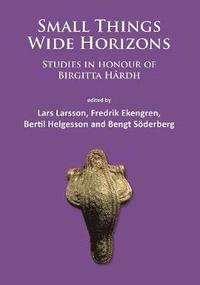
- Format
- Häftad (Paperback / softback)
- Språk
- Engelska
- Antal sidor
- 308
- Utgivningsdatum
- 2015-09-30
- Förlag
- Archaeopress Archaeology
- Illustratör/Fotograf
- Illustrated throughout in black and white
- Illustrationer
- Illustrated throughout in black and white
- Dimensioner
- 300 x 215 x 20 mm
- Vikt
- Antal komponenter
- 1
- ISBN
- 9781784911317
- 1092 g
Small Things Wide Horizons
Studies in honour of Birgitta Hrdh
- Skickas från oss inom 5-8 vardagar.
- Fri frakt över 249 kr för privatkunder i Sverige.
Passar bra ihop
De som köpt den här boken har ofta också köpt Man's Search For Meaning av Viktor E Frankl (häftad).
Köp båda 2 för 721 krKundrecensioner
Fler böcker av författarna
-
Continuity for Centuries
Lars Larsson
-
Principles of Yacht Design
Lars Larsson, Rolf Eliasson, Michal Orych
-
Nationens fiende : om mordet på Olof Palme
Lars Larsson
Innehållsförteckning
Part One - Silver: The background and the early history of the neck rings of the Glazov type (also called Permian) and the beginning of East-West connections in Early Medieval Northern Europe in the 8th and 9th centuries (Johan Callmer); The social weight of silver in the Islendingasogur and the Viking Age hoards (Fredrik Ekengren & Maria Domeij Lundborg); 100 Viking Age hoards of Bornholm: Status, challenges and perspectives (Gitte Tarnow Ingvardson & Finn Ole Sonne Nielsen); Hoards and sinuous snakes: Significance and meaning of ring ornaments in Early Viking Age hoards from Gotland (Christoph Kilger); At the end of the silver flow: Islamic dirhams in Sigtuna and the shrinking Viking network (Mats Roslund); Part Two - Coins: Viking-Age coins found in Sweden (Kenneth Jonsson); The earliest coin hoard of Lund (Jens Christian Moesgaard); Nicholas of St. Albans, Anketil and Alfvini-three Danish moneyers of English origin from the 12th and 13th centuries (Jorgen Steen Jensen); Three Crowns-Coin motive and (trans-)national symbol (Cecilia von Heijne); Part Three - Trinkets: Buttons as brooches (Morten Axboe); Hand rings (Torsten Capelle +); Gold in Guleboda: A Byzantine gold coin from southern Smaland (Martin Hansson); A little piece of silver from the Romele ridge area (Bertil Helgesson); Two brooch-knobs and a handful of thoughts (Karen Hoilund Nielsen); Notices on the Notitia: A comparison between heraldic insignia of late Roman military units as depicted in Notitia Dignitatum and certain patterns on Scandinavian Migration Period jewellery like wrist clasps and relief brooches (Jan Peder Lamm); Close to Asgard - between West and South (Lars Larsson); Shield-formed pendants and solar symbols of the Migration period (Bente Magnus); "Vikings in Bavaria" An unpublished spannbuckla from Munich and its history (Sonja Marzinzik & Michaela Helmbrecht); A female statement of power?: Some reflections on the Viking Age Yelets-brooch (Michael Neiss); A Hind to your Health! (Alexandra Pesch); Part Four - Burials: Small items and major conclusions: A discussion of the findings from Gullhogen, Old Uppsala (Birgit Arrhenius with contributions by Ingmar Jansson); Uncovering more Death: Some recent excavations of graves from the Early Iron Age in Scania (Tony Bjork); Vester Galsted - an inhumation grave at P. Frey's field (Per Ethelberg); Rune-stones and the localisation of graves Burial customs in the Conversion period (Anne-Sofie Graslund); Pidgirci (Western Ukraine) and Havor (Gotland, Sweden)-two grave finds connected with Byzantine Christianity (Michael Muller-Wille); Pot and amulet pendants in the early mediaeval grave 130 of Frankfurt-Harheim (Uta von Freeden); Part Five - Crafts: Production of Scandinavian-style sword hilts on the southern Baltic coast? A stray find, presumably dating to the Late Roman Iron Age, from Lubsow / Lubieszewo in Poland (Andreas Rau, Ruth Blankenfeldt & Jan Schuster); Joining threads - a discussion of the archaeology of the tacit (Ulla Isabel Zagal-Mach Wolfe); Part Six - Farms and fields: What did the Wells conceal? Hvissinge Vest - a Village from the Germanic Iron Age (Linda Boye); Medicinal herbs-useful and fatal: Early traces of medicinal plants in Europe (Ulla Lund Hansen); Part Seven - centrality: Small things and wide horizons from a Birka perspective (Bjorn Ambrosiani & Ingrid Gustin); Detecting Vester Kaerby: Problems associated with the interpretation of metal-detector finds from the plough soil (Mogens Bo Henriksen & Helle W. Horsnaes); Early medieval trading centres and transport systems between Dorestad, Ribe and Wolin: The latest results of the Priority Research Programme "Harbours from the Roman Iron Age to the Middle Ages" (Hauke Jons); Quedlinburg before the Ottonian kings: Approaches towards an early topography of power (Babette Ludowici); The relationship between Uppakra and Lund-a status update (Ing-Marie Nilsson); The Trelleborg constructors
Du kanske gillar
-
Frågor & svar
Chip War
Chris Miller
HäftadMcLaren
Kyle Fortune
Inbunden


